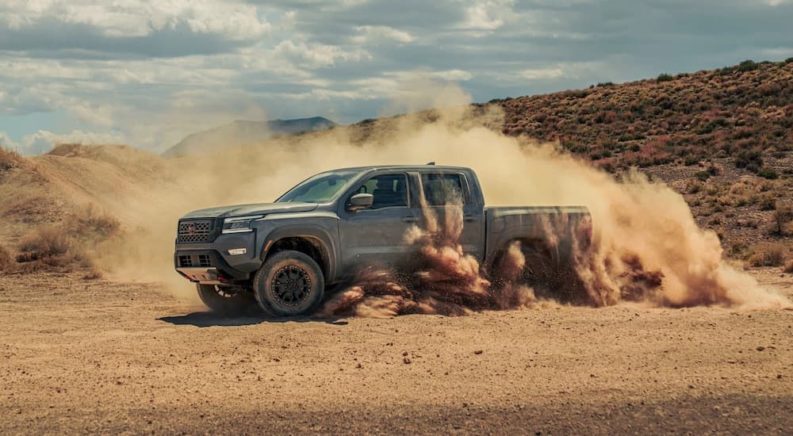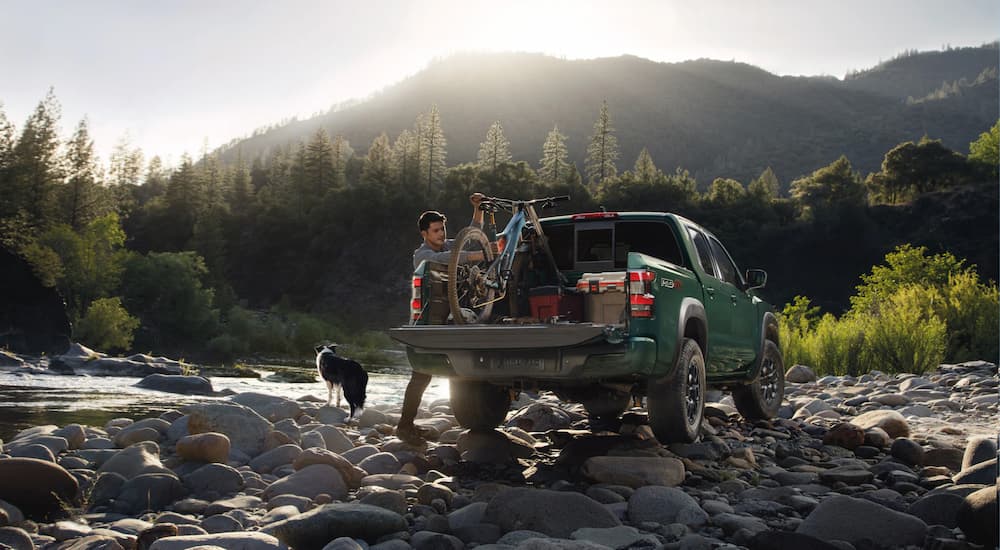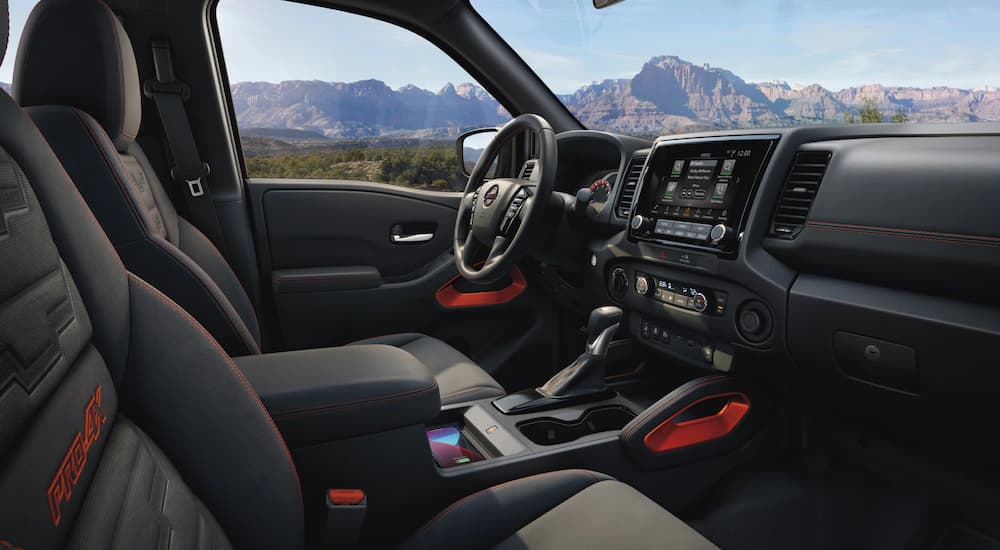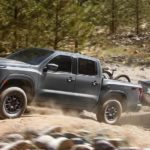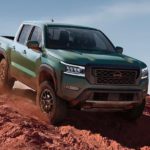Nissan has long excelled in the ultra-competitive pickup sector, producing a line of capable, rugged trucks that also happen to offer surprisingly solid off-road performance. As Nissan’s current midsize offering, the Frontier is one such pickup, featuring a range of trim options that allow drivers to create the ideal ride for any application. Debuting for the 2022 model year, the third-generation Frontier is available in a range of trims, starting with the entry-level S trim for just $28,690. The mid-tier SV is probably the best value in terms of features and price, but it’s the two top trims (the 2022 Nissan Frontier PRO-X and PRO-4X) that really caught our attention this time around.
It Started With the PRO-4X
First introduced in 2006, the PRO-4X package transforms the Frontier into a fully-fledged off-roader with a host of heavy-duty components that allow drivers to explore even the roughest terrain with confidence. With off-road models exploding in popularity in recent years, it came as little surprise when Nissan announced that the new third-gen Frontier would include a PRO-4X model as its top trim. The PRO-4X melds a bevy of off-road features like electronic locking differentials, Bilstein off-road shocks, and underbody skid plates with a well-appointed interior and plenty of high-tech features to create a well-rounded truck that’s well worth the price tag. While the PRO-4X might be the perfect companion for off-road enthusiasts, a new, lighter-duty 2022 Nissan Frontier PRO-X is turning heads while reviving the proud tradition of the off-road prerunner.
Bring on the PRO-X
New for 2022, the Frontier PRO-X slots in just below the PRO-4X in the Frontier lineup, paring back some of the latter pickup’s off-road features to create a rear-wheel drive pickup that can hold its own when the going gets tough. Equipped with the same 3.8-liter V6 as the rest of the Frontier lineup, the PRO-X produces 310 horsepower along with 281 lb-ft of torque. That’s enough brawn to give the midsize pickup an impressive towing capacity of up to 6,470 pounds, making the Frontier a versatile option for those looking for a solid, all-purpose vehicle.
The real highlight of the PRO-X trim is the impressive raft of off-road gear, especially considering the relatively modest starting price of $35,120. The PRO-X adds some tried-and-true off-road components into the mix, including Bilstein shocks, an improved Dana rear axle, skid plates, and 17-inch aluminum alloy wheels. Though less relevant to its off-road chops, the PRO-X has distinctive styling, including Lava Red accents throughout the exterior and interior, charcoal upholstery, LED headlamps, and more.
To truly understand the PRO-X’s place in the Nissan lineup, one must first familiarize themselves with the off-road prerunners that inspired the unique trim. Join us as we dive into the world of off-road racing and how pickups like the 2022 Nissan Frontier PRO-X serve a vital role in the scene despite lacking four-wheel drive.
Start Your Engines
While leagues like NASCAR and Formula 1 might dominate mainstream motorsports, off-road racing holds just as much history and prestige for those involved in the high-octane hobby. Generally speaking, these types of off-road racing competitions can be divided into three categories: long course desert racing, short course racing, and rally racing. Each format holds its own unique challenges, but desert racing is usually considered to be the most demanding, with drivers navigating hundreds or even thousands of miles in hopes of taking home a trophy.
For as long as there have been motor vehicles and people looking to test their limits in the name of excitement, there’s been desert racing. While formalized desert racing traces its origins back to the mid-’60s when Ed Pearlman founded the National Off-Road Racing Association (NORRA), the pursuit actually stretches back a bit earlier in the decade when the team from Honda’s American subsidiary took to Mexico’s Baja Peninsula to test the reliability of the new Honda CL72 Scrambler motorcycle. The team used a Cessna 180 aircraft to scout a route from Tijuana to La Paz that covered some 950 miles while navigating plenty of rocks, dry lake beds, mountain passes, and sand washes to complete the run in just under 40 hours on March 23, 1962.
This feat of vehicular strength quickly captured the imagination of off-roaders the world over, who began to flock to Baja in hopes of besting the 40-hour record. A dune buggy dubbed “Old Red” was the next to capture the four-wheel title, with Bruce Meyers completing the run in 34:54. That record would only stand for a couple of months when an American Motors Rambler American sedan would eclipse Meyers’ run with a final time of just over 31 hours. The informal title chase became a lot more formal in late 1967 with the formation of the National Off-Road Racing Association (NORRA), which would hold the first Mexican 1000 Rally in October of that year. Stretching 849 miles across the Baja desert, the race led to an explosion in the popularity of desert racing and was even covered by ABC’s Wide World of Sports in 1968.
The demanding race was seen as a crucible for testing one off-road prowess and attracted a diverse range of drivers from Indy 500 winner Parnelli Jones to actor James Garner. The Mexican 1000 would continue until 1973, when skyrocketing gas prices due to the OPEC oil embargo saw the race canceled. The Mexican government picked up where NORRA left off, rechristening the event the “Baja Mil” or Baja 1000. Now organized by SCORE International, the Baja 1000 has grown into one of the world’s premier desert racing events, along with the Mint 400 and ultra-long-distance Dakar Rally.
Blazing the Trail
The Baja 1000 has inspired countless other off-road races, which typically cover anywhere between 25 and 1,000 miles and are largely run on government-owned recreational land. These types of races test the endurance of both man and machine, with organization and prep work often playing just as big of a role in reaching the podium as talent and horsepower.
So what does this have to do with prerunners like the Nissan Frontier PRO-X? Well, while each race is different in terms of the type of intel racers receive beforehand, most require each team to scout the route beforehand to familiarize themselves with the terrain, spot any obstacles, and map out a game plan instead of making decisions on the fly while doing 70 mph over challenging desert terrain. That’s where prerunners come in. These lighter-duty vehicles are the perfect option for scouting desert race courses, giving drivers the chance to program GPS markers for relevant road hazards, turns, jumps, and high-speed zones that can be found on any good desert racing course.
This all seems like relatively basic pre-race prep, so why can’t it just be performed by the higher-end racing truck itself? Well, in most competitions, the actual race trucks aren’t allowed on the course until the event starts, making a prerunner a vital part of any desert racing team’s toolkit. While a prerunner can technically be anything from a motorcycle to a dune buggy, many drivers use an off-road-capable pickup as it gives them a chance to feel out the course in the same type of vehicle they’ll be piloting on race day.
What makes a good prerunner? To start, they need to be equipped with off-road tires, a reinforced suspension, and, perhaps most important, a good set of shock absorbers. Prerunners will often have to tackle many of the same obstacles as the high-end race trucks, including some daunting jumps. Beyond the tires, shocks, and suspension, a good prerunner will also have a wide body and roll cage to protect drivers in case of an accident or rollover. While prerunners are sometimes almost as well-equipped as the race trucks themselves, they do differ in some important ways. For example, most prerunners often opt for two-wheel drive instead of a four-wheel drive setup. This helps keep the cost down as it’s much easier to perform a lift on a two-wheel drive vehicle while retaining the pickup’s suspension travel.
While they were once exclusive to mechanically inclined desert racers and those who are handy with a welding torch, major automakers have been building off-the-shelf prerunners for a couple of decades. This includes Nissan, which introduced the Desert Runner version of the Frontier for the 2000 model year. The two-wheel drive King Cab pickup was built on a four-wheel drive frame, giving the truck improved ride height. This, paired with larger tires, a four or five-speed transmission, and a supercharged version of the base V6 engine, transformed the Frontier into the ideal prerunner.
Carrying on the Tradition
The 2022 Nissan Frontier PRO-X carries on the prerunner tradition, giving drivers an exciting new option when it comes to lighter off-road performance. Most importantly, the pickup is just as capable on-road, where the average driver spends most of their time. Nissan has done a good job balancing the truck’s off-road bona fides with smooth, responsive performance on paved surfaces giving drivers an all-purpose pickup that’s equally at home navigating a crowded parking lot as it is scouting the Baja California Desert.
While not quite as rugged as some higher-end production models like the Frontier PRO-4X, the PRO-X fills an important role in the current Nissan lineup. It’s also the perfect excuse for drivers to try their hand at some easy off-roading and represents an affordable entry into the hobby. A marked step up from the new breed of flashy “soft-roaders” that lack any significant off-road upgrades, the Frontier PRO-X is a welcome addition to Nissan’s stable of pickups.

